THE LEGENDARY


ELECTRIFIED: Tyler Bryant, lead singer of Tyler Bryant and the Shakedown, plays the guitar during their set at the MRF. The band came out before Larkin Poe, whose lead singer is married to Bryant.



ELECTRIFIED: Tyler Bryant, lead singer of Tyler Bryant and the Shakedown, plays the guitar during their set at the MRF. The band came out before Larkin Poe, whose lead singer is married to Bryant.
MICHAL KATE CASTLEMAN online editor
OLIVIA WHITLOCK copy editor
With the rise of Netflix and the fall of Blockbuster, there has been a noticeable decline in the availability and consumption of not just DVDs, but physical media as a whole. This shift towards digital media increasingly places the control of media in the hands of corporations rather than individuals.
The Verge reported in Oct. 2023 that Best Buy will no longer be carrying DVDs and then in Aug. 2024 that Target will downsize their in-store DVD selections.
Team Leader Nick Palmer at Slackers CDs and Games in Alton said he is aware of other stores removing physical media, such as DVDs, from their shelves.
“The only way that you can really find [DVDs] is either through Amazon or boutique labels like Vinegar Syndrome or The Criterion Collection,” Palmer said. “So [downsizing] definitely has … a big impact [on the market].”
Palmer said owning and collecting physical media is about art preservation and accessibility. He said that when one relies on streaming services, they are at the whims of corporations.
and you don’t know if your favorite movies are always gonna be there for you to enjoy.”
Streaming services continue to raise their prices, and the number of streaming platforms is growing, making it difficult for consumers to keep up.
“I think we’re already seeing people get tired of streaming platforms,” Palmer said. “Initially, when it was just one or two of them, like Netflix or Hulu, the convenience was there. As more and more companies realize how lucrative it is, they’re all trying to get their own slice of the pie, and that is dividing up everything media-wise to the point where it’s essentially becoming cable again.”
In an article written for Imagine Games Network (IGN) by Amelia Emberwing, she states that people do not fully own their digital media, but instead, corporations do.
“The digital age has introduced an added level of complication to once simple transactions,” Emberwing wrote. “You’re no longer purchasing media; you’re licensing it. That license exists until the company no longer exists, or until the company no longer decides to support the title.”
existence of physical copies less common. This shift is further emphasized by the release of fully digital consoles, which lack disc drives.
“Especially [in] the video game landscape, we’re already seeing a lot of pushback due to the increased difficulty it is to get physical media versions of games,” Palmer said. “And it’s starting to bleed over even into movies, where it’s getting harder and harder to find physical copies.”
Church said owning physical media ensures ac cess to various forms of media, regardless of ex ternal factors.

Mat Piscatella, gaming industry analyst for Circana, said in a tweet that by 2028, he believes digital-only releases will be the norm.
General Manager of WSIE 88.7 “The Sound,” Jason Church, said he advocates for keeping physical media in circulation, as digital media is always changing.
“You might have a favorite movie, you might have a favorite television show, and then … one day, it’s not available any longer,” Church said. “You can maybe find it on this service for $1.99 an episode, or for $14.99 to rent it, or to download it. But things change in that way, in the digital world. Once you have that product physically, you have it there.”
“There have been many occasions recently where my Wi-Fi lost connection,” Church said. “But it doesn’t matter, because I’ve got CDs to listen to, I’ve got DVDs I can put in the player [and] I’ve got records I can put on the turntable to listen to. So, in the case of an outage of any kind, that’s another reason why I think it’s important to have [physical media] around.”
Church said he still purchases physical albums of artists to support them, noting that artists do not profit from streaming as much as they do from sales of physical copies.
“I think the main reason [physical media is important] is accessibility to art. If everything is hidden behind a paywall, you have to subscribe to it monthly. You always have to worry about your favorite movie getting pulled or removed from a service,” Palmer said. “It makes accessibility to these forms of art all the more harder, especially for people with lower incomes. You come to our store to buy a movie for $5, $10 or $15, whereas you have to pay $5, $10 or $15 to Disney+ every month,
Richard Brody wrote for The New Yorker that owning physical media protects against the fear that rights holders might remove their works from the digital landscape due to contracts ending or to create scarcity and boost demand.
Palmer said he has observed customers’ frustration with the decreasing availability of physical copies of video games and movies in stores.


“We’re mainly a game store and movie store, and people are beginning to notice, ‘Oh, hey, I can’t access this old game anymore,’” Palmer said. “Or, ‘I can’t find this old movie on streaming anymore and it’s not available to buy brand new anywhere.’”
Video games are currently in a transition period, with digital purchases and downloads dominating and making the
Not only is general availability an issue, but streaming platforms have come under fire on various occasions throughout the years for modifying lines or scenes in programs. While this is often done to align with our current social climate or make content more appropriate for young viewers, it does change the creator’s original art.
MovieWeb stated in an article about TV shows and movies that have been edited, changed or censored for streaming services, “There has been a concerning trend in films being edited or changed for streaming without the preservation of the original cut. In even worse cases, [streaming platforms] have been removing content altogether, which essentially erases the work from existence in the public eye if there were no physical copies made available.”
“I’m always encouraging people anytime I run into them, and when I get into conversations about this — we really need to get back to at least partially purchasing vinyl, or purchasing CDs or purchasing DVDs,” Church said.
Some believe that supporting, collecting and viewing physical media formats offers a more intimate way to experience the art that enriches our lives.
“Collecting is an act of love … Its essence is found not in the objects themselves, but in the pleasure that they provide, by delivering movies, music, literature — by providing the experience of art,” Brody wrote.
While it is unrealistic for many to own every album or film they enjoy in this day and age, it is important to recognize the significance of keeping physical media in circulation for the sake of preserving art. Physical media is permanent, in the hands of people, while digital media can disappear at a moment’s notice if a person in a suit so decides.
Why the 1-year-old SIUE health insurance plan was issued and how it’s changing the lives of students
CAMELA SHARP reporter
Over a year ago, a new policy was issued by SIUE and approved by the chancellor that mandates that students have health insurance.
In the past, not having it has caused problems for students, putting them in a lose-lose situation.
If students don’t have it, they can’t go to school.
At SIUE, students are to either get the insurance plan through the school or get it on their own. If students can get their own insurance, they must sign a waiver and get approved. For those who have not yet done that, they are immediately enrolled in the insurance plan. The rates have been raised recently, and the insurance now averages at $1,200 for fall and spring semesters and $600 for the summer.
Raburn said that the policy is not from Health Service, but from the university itself, which is a common misunderstanding. However, Health Service is the right place to go if you have questions.
“The policy is actually a university policy. It’s not a Health Service policy,” Raburn said. “Health Service does help manage it and can help with questions and things, but the actual policy was developed by the university.”

Health Service Director Penny Raburn said this health insurance plan is meant to help students avoid extra debt.
“It’s important for students to have appropriate access to care to help prevent future medical debt,” Raburn said.
Student Affairs Special Project Coordinator Michael Schultz said this insurance plan was the solution that the university came up with to help students address their medical problems with more ease. Shultz said the university worked at getting the best price for students.
“We were hearing from students that they were not able to obtain insurance because it was too high-priced,” Schultz said. “What this allowed us to do is go out and — in a competitive market — go ahead and negotiate a price that could be affordable. It is significantly cheaper than going out and buying private insurance.”
Student Government’s Organization Relations Officer Ben Cole, a sophomore physics and mathematics double major,
said that this plan probably makes things a lot easier for international students.
“I can only imagine international students coming to the United States and having to deal with insurance, especially if they’re from a country that has free healthcare. That’s not something that they’re used to,” Cole said. “I do like the fact that SIUE can help them out.”
Schultz said that there was a common issue with older students not being able to finish their degree due to the lack of insurance.
“Older students that have been on their family’s insurance and can only be on that insurance until they’re 26, they would be getting dropped off of their insurance and had no means of getting insurance,” Schultz said. “Some students would get sick or something after they were 26, and they would be so close to graduation, but were not able to finish their degrees because they ran into an issue and weren’t able to get insurance.”
Cole said he appreciates the fact that SIUE enrolls students into the insurance plan before students are able to do it themselves because students don’t typically do it themselves.
“I think it probably is necessary because I don’t think that students would enroll themselves. The university gives them plenty of opportunities,” Cole said. “They send lots of emails to where if they want to opt out, they have the ability to do so. I think it’s better for them to be automatically enrolled because then it also gives them the information.
Raburn said he has noticed that since
the mandatory health insurance plan has been enacted, more students have had easier access to more medical support.
“With students all having the insur-
“ It’s important for students to have appropriate access to care to help prevent future medical debt.”
Penny Raburn Health Service Director
ance, they’re able to find local providers that will take them when previously, some of the providers in the area wouldn’t take self pay or underinsured students when they needed referrals or specialized care,” Raburn said.
Schultz said that it’s important that students’ needs are met and that they are covered.
“We’re meeting a need. There were students that came to us and said that they were having these challenges, and we didn’t have a way of helping them. Sometimes they get a job and there’s a gap there before their benefits start in their new position, so our insurance covers a student if they have that insurance from when they graduated in May all the way through August,” Schultz said.
BRANDI SPANN opinion editor
The Liberty Bank Alton Amphitheater hosted the Mississippi River Festival on June 22. The festival, last hosted in 1980, maintains a legendary reputation in the community, as it shaped a young SIUE into the thriving public university that it is today.
University Archivist and Unique Collections Librarian at Lovejoy Library Steve Kerber said the original festival began as a partnership between SIUE and the St. Louis Symphony Orchestra. The symphony needed somewhere to perform over the summer months, and SIUE was a young university hoping to raise its profile on the east side of the river.
The original Mississippi River Festival took place on the Edwardsville campus in a natural amphitheater in the hills. It ran for 12 summers between 1969 and 1980 and featured performances by major artists like Janis Joplin, The Eagles, The Who, Joni Mitchell and Bob Dylan. After some financial issues and complications continuing the festival, Kerber said the university intentionally returned the amphitheater to nature.
Mark Pierce is the author of “When the Stars Came Out: The Story of the Mississippi River Festival.” The book is currently available at the Cougar Store.
“It always fascinated me that right there in our backyard in Edwardsville at SIUE was The Who, The Eagles, the Grateful Dead … but it was more than
that. It was folk, theater and dance,” Pierce said. “The MRF seems to be having a bit of a resurgence right now … People want to hear about the MRF. They want to relive the MRF.”
Though this revival of the festival may not be the same as it was in the past, Pierce said it’s a great thing to see people having a great time under the banner of MRF.
“You and your friends would grab food and a bottle of wine
“ [Music is] something that everybody can identify with. It speaks to our hearts and to our memories.”
David
Goins Alton Mayor
and throw out a blanket on the lawn and watch Joni Mitchell. That whole spirit of going out and seeing live music — being with your friends and being under the stars — this is bringing that back,” Pierce said. “There’s still an audience for this.”
Alton Mayor David Goins said that the city wanted to bring the festival to the riverfront.
“The whole idea of the Mississippi River Festival actually being on the river gives it a nice touch and nice feel, and I believe it’ll be a really big boost for our city,” Goins said.
The festival hosted local vendors and honored performances
from the original festival by projecting images of artists from the ‘70s onto the big screens in between acts. Audience members of all ages came from near and far to support the lineup of rock bands FEEL, Fastball, Tyler Bryant & The Shakedown and Larkin Poe.
Scott Wilson, assistant stage manager from the original festival, sat atop the hill showing people his old backstage ID. He worked for SIUE’s MRF after returning home from Vietnam. He is excited that he was able to witness the return of the festival.
“I’m alive to hear it,” Wilson said.
“[Music is] something that everybody can identify with. It speaks to our hearts and to our memories,” Goins said. “It’s a universal language.”
The Liberty Bank Alton Amphitheater is located right on the river, giving the audience a view of a skyline that features Alton’s Clark Bridge. Though the evening started out in sweltering heat, the setting sun cooled down audience members and made way for the strawberry moon to pass over the stage as Grammy-award winning headliner Larkin Poe honored women in blues and rock and roll.
Festival attendee Christopher Jennings drove 10 hours from his home in Texas to see the opening act, a local band called FEEL.
“I met a couple [in line] ahead of me — an older couple. They know the guitarist, Tyler. Apparently, he lived in their basement and they supported him locally,” Jennings said. “Really small band, retro
sound, really influenced by the ‘70s British blues rock. Lots of hair, lots of denim, [a] really groovy band.”
Jennings said it’s not often that festivals have tickets that cost $25. He said he enjoyed coming to Alton and that the festival is a great way to bring people together.
“Not to discredit other genres, but when Woodstock came back, they incorporated a lot of the newer sounds. I like that they kept it very authentic with the Mississippi River Festival and have a lot of bands that are influenced by those other decades,” Jennings said.
Niki Opel, a former student at SIUE and cous in to FEEL bassist Rodger Lenhardt, stood in the front row to watch her cousin perform.
“He was in four bands at one time. That’s been his whole life,” Opel said. “He played down in Tampa, Florida, with Black berry Smoke. We went down and saw him and it’s just — he’s the kid I grew up playing Mario Kart with. When I see him, I’m like, ‘That’s my guy!’”
down on how it’s been away for 44 years, and the last people to close it out were ZZ Top. For us to be the ones to bring it back and open it up, even though we’re just the opener, it’s … sick,” Barcus said.
Audience members Katrine Seghetti and Pat Woods are fans of headlining act Larkin Poe and opening band FEEL. They had both been on the lawn at the original festival at SIUE watching Poco in 1978. That was where they met.
“I thought he was hot!” Seghetti said.
“Back then, I was,”
“You still are,”
tival. She said that she is excited that blues, rock and folk music are crossing
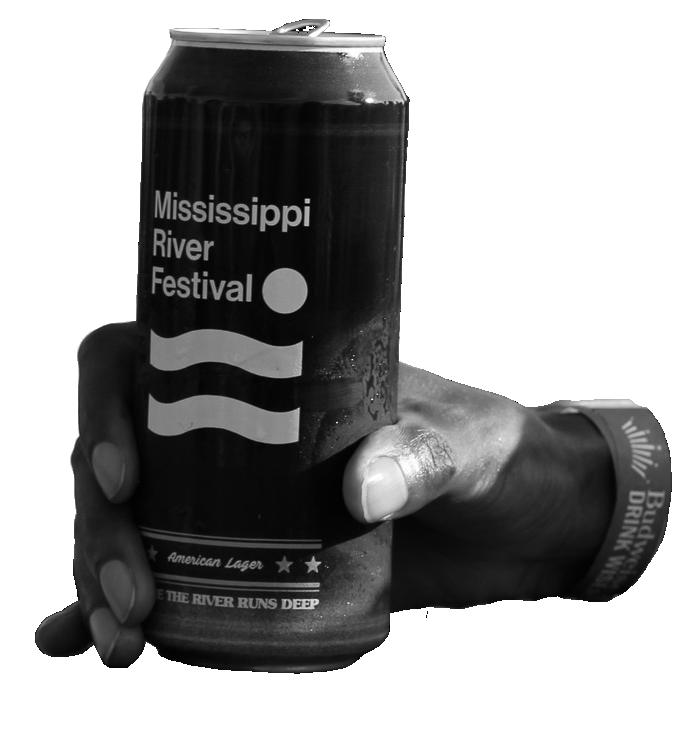
FEEL vocalist Garrett Barcus joined the band a little more than a year ago. He said that festivals provide a space for a range of creativity to be expressed on stage.
“I didn’t know of the importance of [the festival] … [FEEL’s guitarist] gave me the whole low-
CAMELA SHARP reporter
Less than a year ago, the John Martinson Honors Program received what they call a “gift” rather than a donation, and it has helped them reshape and improve the program in a multitude of ways.
The John Martinson Honors Program is designed to give students the opportunity to take the lead on their education and experience education in a more innovative and independent way.
The orchestrators behind this program have big dreams and big goals for their students, and now that they have a $4 million gift to support them, they can start checking off more boxes.
Director of the John Martinson Honors Program Eric Ruckh said a couple of official changes include approval to hire people for new positions and build a new space for them in Lovejoy Library. He said that these changes will play a key part in increasing the size of their classes.
“We got approval and have hired a marketing specialist to help us recruit and market the John Martinson Honors Program. We also got approval to hire a second adviser.” Ruckh said. “The publicity specialist, marketing person and the second advisor are necessary in order to allow us to grow, over the next four years, the size of the honors program.”
Office Manager of the honors program Veronica Hoversten said that they can now cater to students’ educational needs better by being able to send them to locations for experiences that they may not find otherwise.
“We have the ability to send people places to learn, and that’s something
that’s really exciting. If a student comes up to us and says, ‘Here’s this conference I want to do,’ or, ‘Here is this experiential learning opportunity that I want to do,’ — for instance, like Partners in the Parks where you go to a national park and you learn for summer break — we can afford to do that now, and that’s just fantastic,” Hoversten said.
A common hot topic among the orchestrators of the program is their new ability to send or take students out to travel, whether it be for a conference, a service trip or to study abroad. Ruckh said that John Martinson, the donor of the $4 million, valued students’ abilities to study abroad.
“Last year in the spring, the honors program was able to support a trip to Guatemala that was led by a number of nursing faculty. The gift allows us to support students who ask for support to study abroad,” Ruckh said. “We are developing a process that will allow honors students to request funds to … help pay for study abroad opportunities next year.”
The honors program is housed in Lovejoy Library. However, they are separate organizations. One of the biggest changes is the construction plans for the third floor of Lovejoy Library for the purpose of creating more offices and more space for honors students.
“We are still working with architectural plans for the third floor of Lovejoy Library. Each meeting iterates a more precise plan for office spaces, a student lounge [and] shared spaces with the library and the conference room. That work is ongoing,” Ruckh said. “The hope is to have a plan done so that sometime during this upcoming academic year,
building can begin on the third floor of Lovejoy Library.”
Junior and nursing major Nariah DeArmon, a student worker for the honors program, said that since the donation, they have been able to cater to the needs of freshman students more and help them settle in more easily.
“We are able to let the freshmen move in a day before everyone else,” DeArmon said. “This is so we can get them a day to process and to be able to acclimate and pick the first bed and be able to be there first.”
Ruckh said that the ultimate goal for the future is for the program is to one day become a college of its own.
“We want to build a faculty fellow program so that we can do the necessary work to review the curriculum, to train more faculty to teach more honors courses so that in roughly four years we will be in a position, both spatially in terms of personnel and in terms of budgets, to win approval to turn the honors program into a college,” Ruckh said. “That’s the long-term goal.”
Ruckh said that another goal is for the rate of students graduating within the program to grow abundantly.
“[We would also like], over the next four years, to double the size of the Honors Program so that by around the fall of 2028, we would be bringing in roughly 250 honors students in each class so that there’d be roughly 1,000 or 1,100 honor students on campus,” Ruckh said. “We want to make sure that we not only sustain but increase the already high graduation and retention rates for the program.”
“I think it’s awesome what this is doing [for] Alton — bringing arts and music back to the city. We’re trying to bring it to a new generation,” Wolfe said. “The bands that we’ve got are a real good variety of young and older music.”
see FESTIVAL on page 12

06.19.24
Officer responded to a report of tree limbs, lawn debris and fabric dumped near the parking lot.
06.22.24
Officer responded to a report of a subject sleeping on a bench. Officer advised contact was made with subject and subject agreed to leave the area.
06.23.24
Officer assisted Edwardsville PD with attempting to located a vehicle whose occupants were allegedly involved in a robbery. Officer advised vehicle was located by Edwardsville PD.
06.23.24
Officer responded to a report of a vehicle driving the wrong way and tailgating other drivers. Officer advised vehicle was not located.










THE ALESTLE STAFF editorial board
Just across from the bathrooms on the ground floor of the Student Success Center is a vending machine, but instead of chips and soda, it contains various medications and health products. The kiosk is very wellstocked and maintained, especially for college students in a financial pinch.
At this time, the kiosk is out of order beacause of contractual negotiations.
motes reproductive health by carrying condoms, tampons and generic Plan B.
EContra One-Step, as it is labeled in the kiosk, is the same medication as that found in Plan B. Brand-name Plan B is very expensive, often priced at around $50.
Pharmacies do offer generic Plan B as well, but it must be run through an insurance plan, and depending on how busy the pharmacy is, it may take multiple hours to prepare.
fenesin, which is generic Mucinex. Not only does this medicine target mucus buildup deeper in the respiratory tract, but it is also a viable alternative for people who cannot take antihistamines due to drug interactions — unwanted reactions between medicines in the body that may result in serious side-effects.
ent creams for skin conditions and laxatives.
While the kiosk offers both proactive and reactive contraception, it does have one shortcoming. The kiosk only carries latex-based condoms, which aren’t a viable option for people with latex allergies.
HAVE A COMMENT?
Let us know by scanning here: Campus Box 1167 Edwardsville, Illinois 62026-1167
LETTERS TO THE EDITOR POLICY: The editors, staff and publishers of The Alestle believe in the free exchange of ideas, concerns and opinions and will publish as many letters as possible.
Letters may be submitted to: The Alestle Morris
message is not lost or altered.
Letters to the editor will not be printed anonymously except under extreme circumstances. We reserve the right to reject letters.

The first thing to note about the wellness kiosk is that most of the products are generic versions of over-the-counter medications. While some look at generic medicines reluctantly, the Food and Drug Administration requires that they be just as high-quality as brand-name drugs. Whether the box says “cetirizine” or “Zyrtec” on it, you’re taking the same medication.
Perhaps the best aspect of the wellness kiosk is that it pro-

DYLAN HEMBROUGH
editor-in-chief
From debates over the rights of women and the LGBTQ+ community to questions about whether the rule of law applies to our highest leaders, we seem to be living in an echo of the “simpler times” certain generations are so fond of.
Some have compared the explosion of pro-Palestine protests on college campuses to the anti-war protests of the late ’60s and early ’70s. It’s easy to see why: the government is out of touch with citizen anger and frustration over a war that many see as unnecessary.
The gay liberation and feminist movements of the ’70s also carry on today in modified forms. While it is more socially acceptable, a strong argument can be made that it is still unsafe to be queer in America. And, while the glass ceiling has cracked a little bit, there is still a considerable wage gap and general hierarchy along gender lines.
The fact that the wellness kiosk offers immediate access to emergency contraception is a game changer for college students, especially considering how expensive it typically is off-campus.
If you’re suffering from a stuffy nose or phlegm buildup in your windpipe, the kiosk has you covered. There are two antihistamines in the kiosk, cetirizine and Banophen, which can be used for seasonal allergies.
The kiosk also carries guai-
In the case of antihistamines, some people are prescribed them for non-allergy purposes, such as for panic attacks. Including generic Mucinex as an option in the kiosk is a very good call.
The kiosk also has acetaminophen — which is generic Tylenol — and ibuprofen. Both can be used to treat pain and inflammation, and Tylenol can also relieve fevers. Both are very common, very safe medications.
The kiosk carries calcium carbonate — generic TUMS — for acid reflux, commonly known as heartburn.
Also available is Dramamine, which can be used to treat motion sickness, as well as differ-
The kiosk could also benefit from informational pamphlets on medicines to avoid if using the kiosk, or even a list of what each medicine treats. While most drug interactions can be uncovered with a quick Google search, someone in a hurry may not think to look if their cure for a runny nose can or cannot be paired with anxiety medication.
That aside, the wellness kiosk appears to be stocked with care and attention. Its convenient location on campus ensures that people who may not have ready access to transportation can still access useful medicine.
If you are ever unsure about a medicine you are about to take, contact your doctor or local pharmacist.
1974 or 2024? HAVE WE MADE
The country has also regressed regarding bodily autonomy and reproductive rights. Considerable progress was made in 1973, when Roe v. Wade was decided. In 2022, states were able to roll out abortion bans en masse after the Dobbs decision, which overturned Roe, and further legislation aims to prevent people in need of an abortion from leaving the state to do so.
August 9 will mark 50 years since President Richard Nixon resigned from office after the Watergate scandal was uncovered. Legally, Nixon got off scotfree after trying to undermine our democratic processes. The whole situation eroded trust in the American system, and that same trust is virtually nonexistent today after the chaos of the Trump administration.
Among the similarities between those days and these days, however, lie several key differences that could make or break our future. Let’s revisit those protests.
Generation Z is not being
drafted and sent overseas to fight in Palestine. While college campuses have been and still are hotbeds of debate, the situations in Vietnam and Gaza are very di fferent.
This is not to say that Gen Z isn’t affected by the war, though. In many ways, the war is closer to them than Vietnam was to the college students of the ’70s.
Not only does Gen Z have access to unfiltered images of gory scenes halfway across the world, but many universities — SIUE included — have students who have families in the area and are directly affected by the war.
Like the protests of the ’70s, students face the threat of arrest as well. Many peaceful protests, such as the one at Washington University, have resulted in dozens of arrests and injuries.
But, protesting does work. The U.S. ended its involvement in Vietnam partially because of how unpopular the war had become back home. This time around, the internet exists. Sure,
college students back then read the paper and watched the news, but they did not have the constant and instant connection that Generation Z does. There has never been a moment in history where humanity has been so connected and aware of what’s happening around them. Protests are about the most visible form of dissent that citizens have, and the internet only enhances that.
What the younger generations, as the future of this country, have to do is keep voicing our opinions. And they need to do it loudly and proudly. Many of those in power right now will not live to see the consequences of a broken climate and breaking democracy, but the younger generations will. The fact that this country has made it this long means that the right kind of resistance does have an effect. This country will not move forward without some serious changes. Let’s make those changes happen.

AVA GALBAN reporter
From the impeccable acoustics to the controlled climate, indoor concerts provide an ideal setting for both artists and fans. These venues transform live performances into unforgettable events, making them the top choice for many music lovers.
Indoor concerts, often hosted in venues such as theaters, arenas and clubs, offer a unique and intimate experience that is arguably superior to their outdoor counterparts. While outdoor concerts have their perks, the controlled environment of an indoor concert provides several significant advantages that enhance the overall enjoyment and quality of the live music experience.
Firstly, the acoustic quality of indoor venues is unparalleled. Concert halls and arenas are designed with sound quality in mind, utilizing advanced acoustic engineering to ensure that every note resonates clearly and powerfully throughout the space.
Indoor venues are equipped to handle complex sound systems that can deliver the music as the artists intended, providing a richer, more engaging auditory experience.
This is a stark contrast to outdoor
venues, where sound can often get lost in the open air, potentially losing clarity and impact. Additionally, depending on the size of the outdoor venue, the sound may not always reach concert-goers well enough to have the immersive experience concerts strive to provide.
Climate control is another critical factor that makes indoor concerts preferable. Weather can be unpredictable, and outdoor concerts are often at the mercy of elements such as rain, wind and extreme temperatures.
An unexpected downpour can dampen spirits and equipment alike, while sweltering heat or biting cold can make it challenging for both performers and attendees to enjoy the event.
Indoor venues eliminate this uncertainty, providing a comfortable environment regardless of the season. This not only ensures that the performance goes on without weather-related interruptions, but also allows the audience to focus entirely on the music.
The ambiance of indoor concerts is also a significant draw. The use of lighting, stage design and visual effects can transform a concert into a spectacular show. Indoor settings allow for controlled lighting conditions, making it possible to create dramatic effects that enhance the emotion-
al and visual impact of the performance.
From intricate light shows to vivid projections, the visual component of indoor concerts can elevate the experience to something truly magical— something that is often harder to achieve in an outdoor setting.
Additionally, the intimacy of indoor venues contributes to a more personal and engaging experience.
Whether it’s a small club where you can be just a few feet away from the performers or a larger arena where the design still keeps the audience relatively close, indoor concerts foster a sense of connection between the artists and the audience.
This proximity can create a more immersive and emotional experience, allowing fans to feel more directly involved in the performance.
Logistics and amenities also play a role in making indoor concerts superior. Indoor venues typically offer better facilities, including seating, restrooms and concessions.
Accessibility features such as ramps and designated areas for individuals with disabilities are more common and better maintained in indoor settings. These amenities contribute to the overall comfort and convenience of attending a concert, making the experience more enjoyable
from start to finish.
Furthermore, indoor concerts often have a more predictable and organized structure. The enclosed space allows for better crowd management and security, ensuring a safer environment for all attendees.
Entry and exit procedures are more streamlined, reducing the stress and chaos that can sometimes accompany large outdoor events.
Finally, the sheer variety and frequency of indoor concerts provide more opportunities for fans to see their favorite artists.
Many musicians prefer indoor venues for their tours due to the controlled environment and guaranteed quality of the performance. This means that fans have more chances to attend concerts throughout the year, regardless of weather conditions or seasonal limitations.
While outdoor concerts have their own unique appeal, the reliability and absorbing nature of indoor concerts make them the best kind of live music events.
Whether you’re attending a concert in a grand arena or a cozy club, the controlled environment ensures that you can fully immerse yourself in the music, creating memories that last a lifetime.
TORI WATERS copy editor
Why feel cramped indoors when outdoor concerts are available to provide a scenic, spacious form of entertainment?
When planning a concert, choosing the right venue is an essential part of the process. The most noticeable thing about a venue is whether it is indoors or outdoors. When planning your next outing, I urge you to experience the wonders outdoor concerts have to offer.
Once-in-a-lifetime opportunities occur during outdoor concerts, like the possibility for music festivals. A popular music festival in Illinois is Lollapalooza. Lollapalooza features hundreds of artists along with many amenities. There are so many activities and options offered at Lollapalooza that this festival offers a map to fully enjoy every inch of the festival.
Outdoor concerts offer a beautiful ambiance and atmosphere that indoor concerts could never replicate. Baby blue skies, giant fluffy clouds, luscious green grass and a
slight breeze add to the irreplaceable scenery of outdoor concerts. Not only is the daylight gorgeous, but when the sun goes down, the sky is painted with extravagant colors. Imagine watching the sunset and dancing under the stars to live music.
Unbelievable scenery is not the only positive to enjoying an outdoor concert.
Space and comfort is an attribute outdoor concerts do best. Venues tend to be massive and allow more people to attend while still providing personal space. This optimal space allows you to lay down blankets without touching the person next to you. Typically, at an indoor concert, you will be shoulder-to-shoulder with someone and breathing the same sticky air, but outside, you have the freedom to breathe fresh air without being bothered.
While atmosphere and comfort is important, it is also vital to take into consideration that sometimes Mother Nature can play a role. Outdoor concerts can be canceled or postponed due to rain, or you could be rained on during the concert which leads to a messy, muddy mess of people running out of the venue together.
Mother Nature can also be a positive. Musician Zach Bryan has a song titled “Snow,” and he performed his song outdoors while it
started to slightly snow. False snow and a fake background upon a screen simply cannot compete with the beautiful effects of nature.
Indoor concerts may provide opportunities for enclosed and enhanced light shows, but outdoor venues extend the lights and sounds of a live show into the surrounding communities, pulling in more than just ticket holders. It is common for others to sit outside and listen to live music. Whether you camp outside the concert or happen to walk by, outdoor concerts create a shared experience for the entire community.
Though it may seem like there are more accessibility options for indoor concerts, that is not entirely true. Outdoor concerts tend to have massive stairs and ramps for anyone to use freely. Along with that, there are huge paths that continuously have open space to assist you in a panic-free scenario.
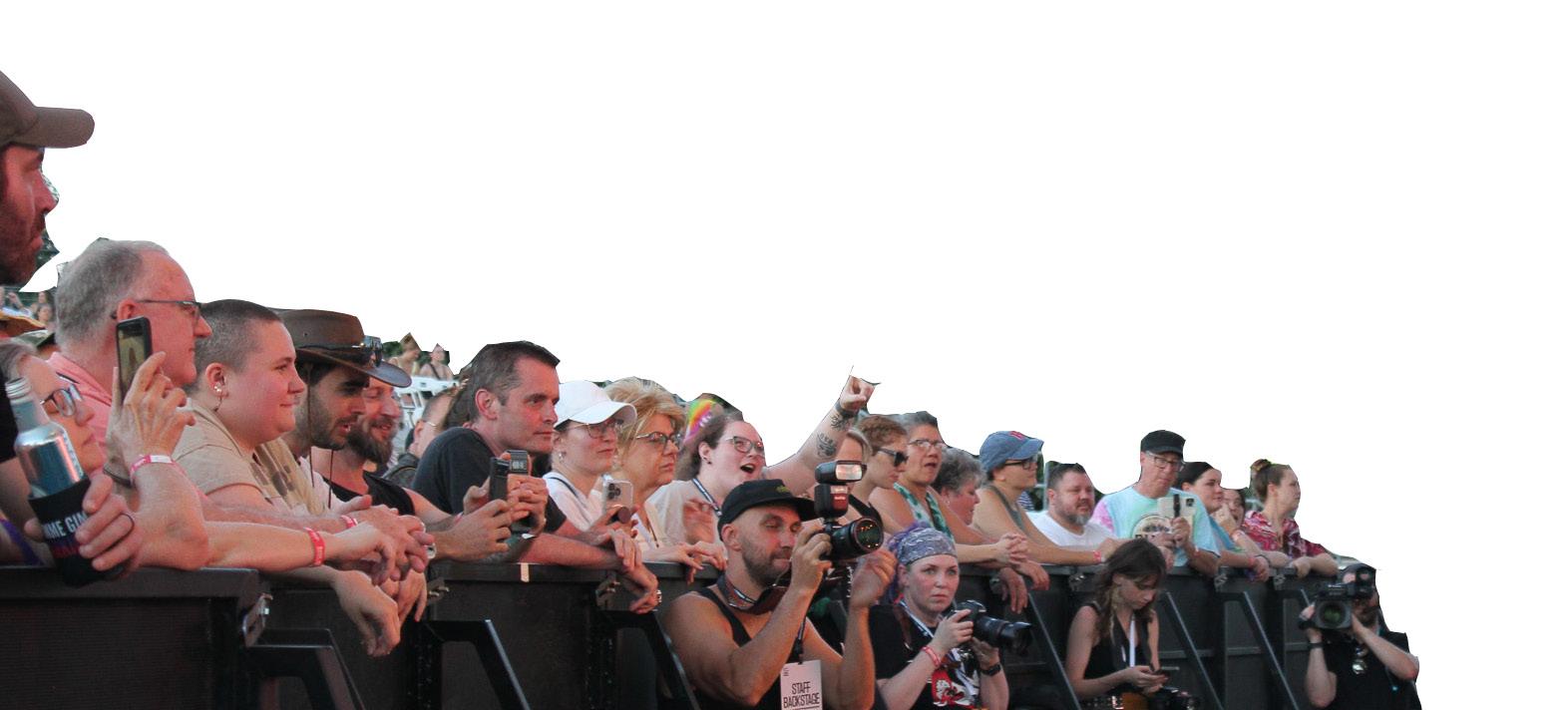
Outdoor concerts also provide individuals with massive amounts of amenities. In St. Louis, the Holly-
wood Casino Amphitheatre has massive bathrooms, many food options, tents for merch and even a snow cone shack, all of which are placed strategically apart from each other to avoid extreme crowds and discombobulation.
Outdoor venues have unlimited opportunities for scenic ambiance. The Red Rocks Amphitheatre in Colorado, for example, is surrounded by enormous textured rocks, providing a unique experience for the audience and performer alike.
Overall, outdoor concerts are unbeatable. Nothing compares to listening to live music and having the privilege of endless space and the great outdoors. Enjoy the beautiful seasons completely by attending an outdoor concert.

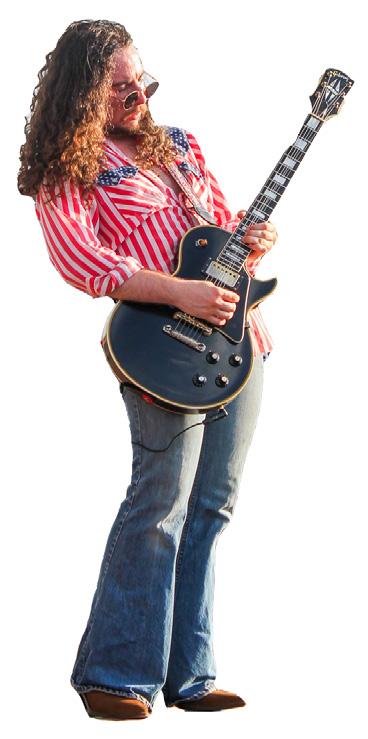
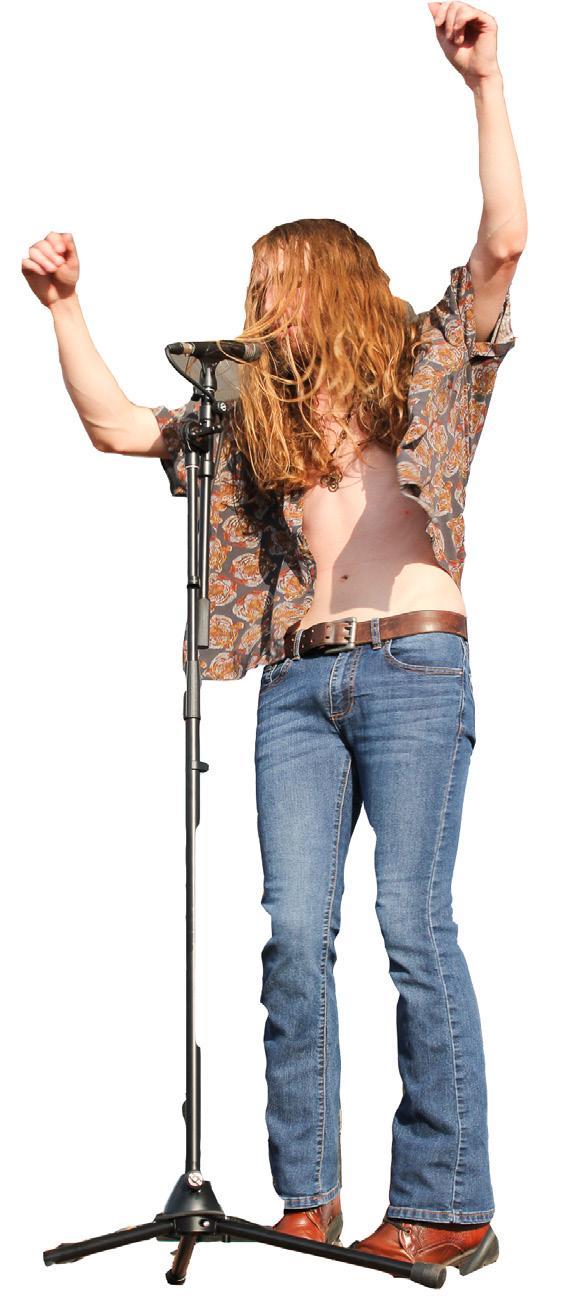

Artwork by T. Weltzin
We reviewed local record stores from Edwardsville to St. Louis. While the record is the most important component, the perfect experience comes with friendly service, a good price and good vibes. We rank based on ambiance, selection, price and service — reviewing local record stores to fnd your perfect ft.

T. WELTZIN illustrator
If you’re looking for a calm ambience and good prices, RiverBend Records in Godfrey, Illinois, will not disappoint you.
This unassuming store sits next to a donut shop that was seemingly unoccupied at the time. The record store itself was nearly vacant as well. I walked through the aisles and was pleasantly surprised to find vinyls of my favorite artists that I had never seen in person.
In every aisle, the records were rated with grading scores that helped indicate the price of a record. That being said, I
didn’t see any individual record over the price of $40 and under the price of $5. Every record appeared well-maintained — even the lower-priced ones seemed in near perfect condition despite their rating.
The staff was very helpful in my exploration, answering questions that I usually would’ve been too shy to ask. One of the staff members even knew an artist that no one else I have talked to knew of.
All in all, I would 100 percent go back to RiverBend Records. The staff was incredibly helpful, the ambiance was chill, it wasn’t crowded and I didn’t feel rushed. I ended up getting three brand new albums for only $88.
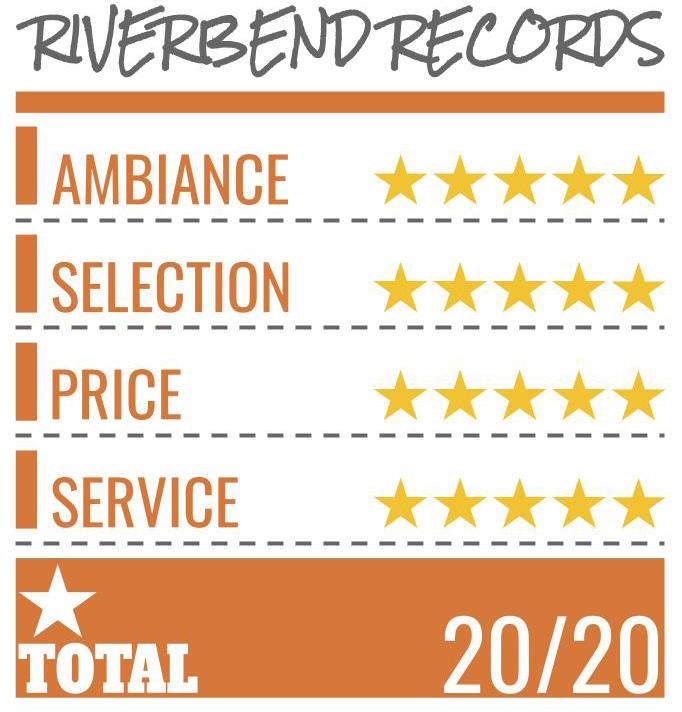
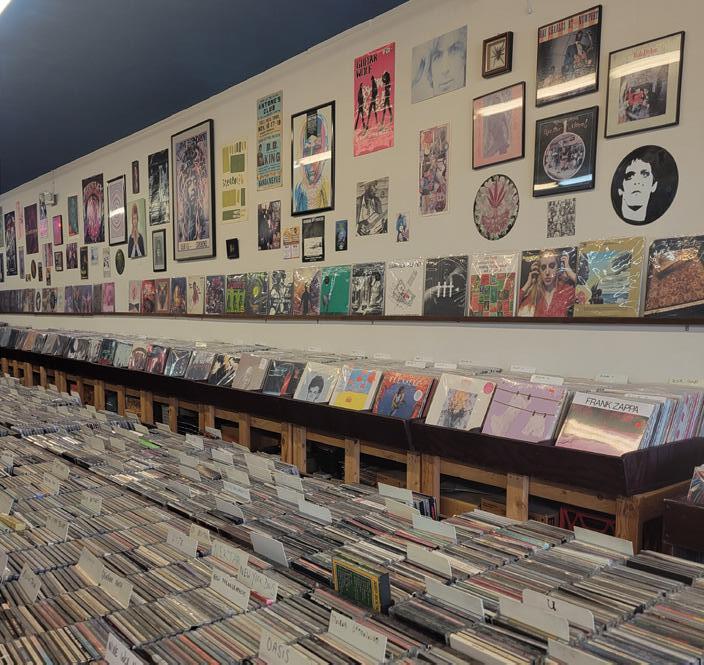
BRANDI SPANN opinion editor
In the Maplewood neighborhood in St. Louis, Planet Score Records is a must-visit.
The interior of the shop is small, but they make great use of the space by displaying their CDs and vinyl records in compact, alphabetized shelving units.
They have a decent variety of artists and genres available to browse through. I was thrilled to find albums by Joni Mitchell, Phoebe Bridgers and Sinéad O’Connor. Their collection of options is nothing extraordinary, but they will likely carry any classics or popular releases
one might be looking for.
The employees were friendly and accommodating. Next to the checkout desk was a pile of new arrivals he was still in the process of pricing. Chappell Roan’s vinyl album “The Rise and Fall of a Midwest Princess” caught my friend’s eye, and he offered to hurry through processing it so that she could have it.
The prices at Planet Score Records are average. I ended up buying a used CD of Bon Iver’s self-titled album. It cost $7.65 with tax. Most of the CD prices range from $5 to $7. New vinyls are about $30, and used vinyls are about $12.
I left the store satisfied, and I would not turn down the chance to go back again.

You can trust Trusty Chords for high-quality records
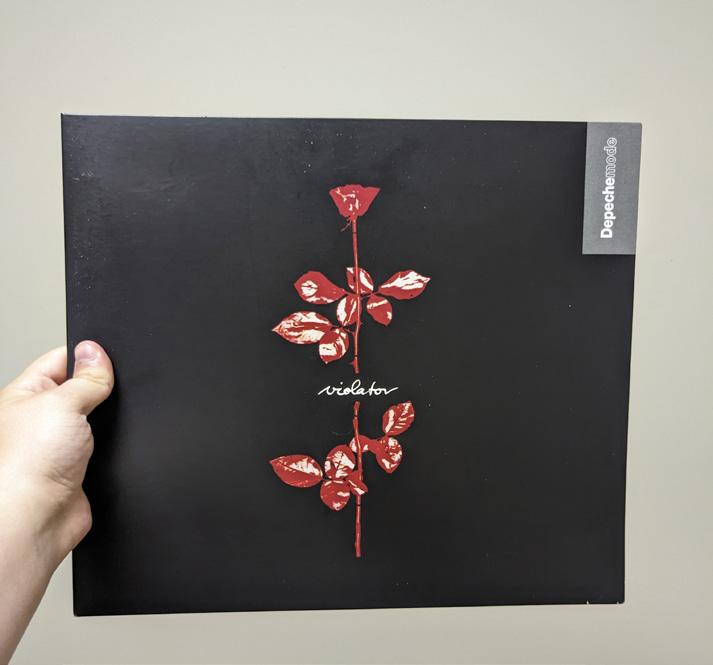
DYLAN HEMBROUGH editor-in-chief
Just off Troy Road in Edwardsville is a smaller record shop called Trusty Chords Record Shop you will certainly find yourself immersed in.
The store is cozy and organized very well, with the typical genres like rock, metal, pop, jazz and country adorning the shelves that form a horseshoe shape around the store.
In the middle of the store are a couple more shelves full of CDs, most of which are very reasonably priced. The records themselves are a little on the expensive side.
The store also prominently displays newer works near the cashier’s desk, which is where I bought Hozier’s “Unreal Unearth.” While this was in the neighborhood of $40, I have found other, much cheaper albums. “Chicago IX: Chicago’s Greatest Hits” came in at just a few dollars.
Below the main shelves, there are rows upon rows of $5-or-less records for customers to choose from. I got my fiancée a Doobie Brothers record from this section.
I have never walked out of Trusty Chords disappointed. Even though I couldn’t find a Def Leppard album, Hozier came to the rescue.

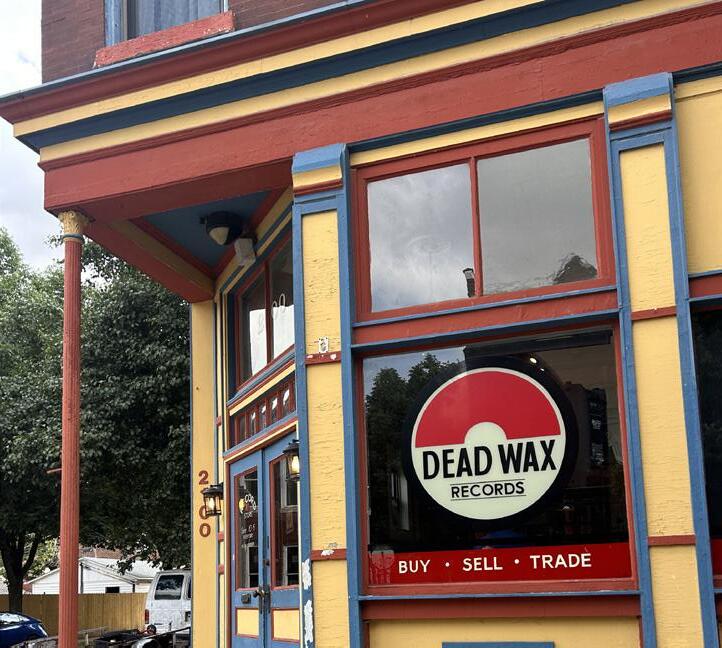
TORI WATERS copy editor
Dead Wax Records is on Cherokee Street in St. Louis. Although this record store is small, its aesthetic makes it feel much larger.
Dead Wax Records illuminates the street with its bright yellow base color with blue and red outlining each window and pillar. Inside, the ambiance stays consistent. The interior is primarily white, but posters from albums fill the space and create a chillax grunge vibe.
There is a staircase that leads to a loft offering an overview of the record store.
The loft also features a massive record player for anyone wanting to test a vinyl before purchasing.
As a lover of older music, I was mesmerized by all the options inside. Vinyls ranged from artists like Johnny Cash, Fleetwood Mac and many more. I settled on Fleetwood Mac’s 13th studio album, “Mirage,” which only cost me $8. Prices tended to stay around the $8-15 range unless they were rare.
Overall, my time at Dead Wax Records was one for the books. I fell in love with the ambiance and seemingly endless options of vinyls and the employees were super helpful and genuine.
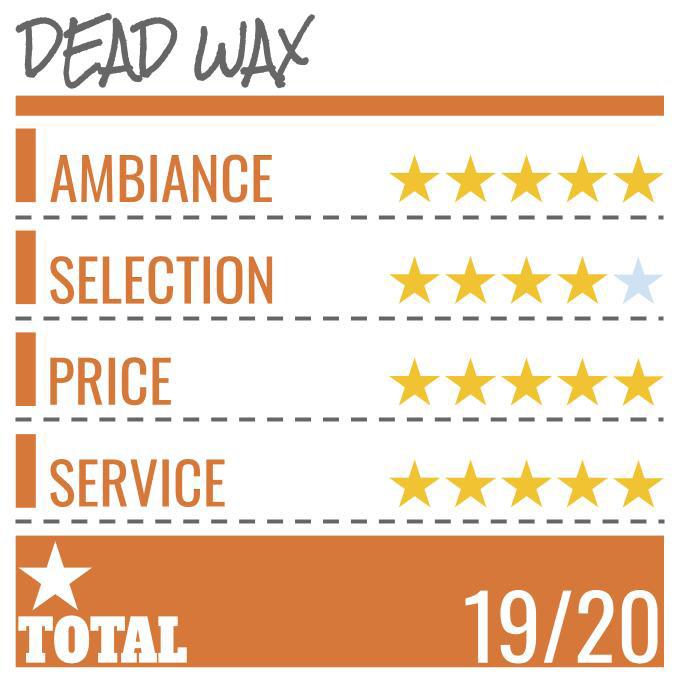
place you have to go to now!

CAMELA SHARP reporter
Small but hard to miss on South Grand Boulevard in St. Louis is Circa: Now!, a record store with a lot of character and a whole lot of options with music from a variety of time periods and genres.
The welcoming environment is immediately apparent as guests arrive, with the door wide open. The windows offer a great view into the beautiful vintage look on the inside as it is decorated with multiple posters from classic artists and a cardboard cutout of Freddy Krueger.
As I walked in, the ambiance matched the wonderful sound of ‘80s rock that filled the store.
The inside is small, but not cramped as the space is full of vinyls, CDs, DVDs, books and even turntables, all neatly organized and fairly priced.
The owner is a kind, attentive man, which showed greatly as he thoughtfully helped navigate the room and the options within.
Within these multiple, seemingly endless bins, these mostly used options vary from Tina Turner, Pat Benatar, Alvin and the Chipmunks, Diana Ross, Rick Wakemen, Jack Harlow, to even the We Are the World album.
The bins featured genres like jazz, alternative, punk, reggae, soul, rhythm and blues, rock and more.
These treasures go for as cheap as 50 cents. However, the turntables are at least $100, which is worth it, in my opinion. On average, the vinyls are between $5 to $7.
I walked away empty-handed for the time being, but I definitely plan on coming back for a turntable and a Tina Turner album.


TORI WATERS copy editor
Vintage Vinyl is a large record store located on Delmar Boulevard in St. Louis. Located in the Loop, there are many little stores on the strip, but Vintage Vinyl stands out amongst the other stores.
Inside, the walls were filled to the brim with posters, stickers and other vinyls. It was the kind of record store I would imagine in a movie.
While browsing, I was amazed by all the options available. Vintage Vinyl is a rather bigger building, and there were vinyls covering the store from the front to the back.

I landed on an exclusive version of Chappell Roan’s debut album “The Rise and Fall of a Midwest Princess.”
My browsing did not stop there. I ventured towards that back of the store and locked my eyes on an EP by Boygenuis titled “boygenuis.” While in the same spot I turned around to see the newest album from Wallows titled “Model.” Both of these vinyls were priced for $29, which I thought was reasonable.
I brought my sister along for the journey and she was looking for the “La La Land” soundtrack and found no luck. We asked a worker and he looked it up, but he did not seem like the most friendly person in the world.

On Hampton Avenue in St. Louis, Record Exchange is a must-visit for music lovers of all ages — just remember to bring some allergy medicine if you are allergic to dust.
With a massive, maze-like collection of affordable, used records, CDs, turntables and stereo systems, if I’m looking for anything pre-2000, this place has it.
Because all the products are used, they are cheaper. But every vinyl I’ve bought from Record Exchange has been usable and in excellent condition.
My only complaint with Record Exchange is the dust. Because the building is
so massive and full of products, it’s obviously difficult to dust. Despite this, I still enjoy wandering around the store.
Record Exchange is a maze but the employees are very good at helping you find anything you could ever need.
I asked an employee where I could find a David Bowie records and he took me to seemingly the only Bowie record in the store, and I ended up purchasing it along with “Diamond Life” by Sade. I only ended up spending around $20 for both.
The reason I keep coming back is the selection, amazing employees and gorgeous store. This is definitely a must if you are ever in the area.
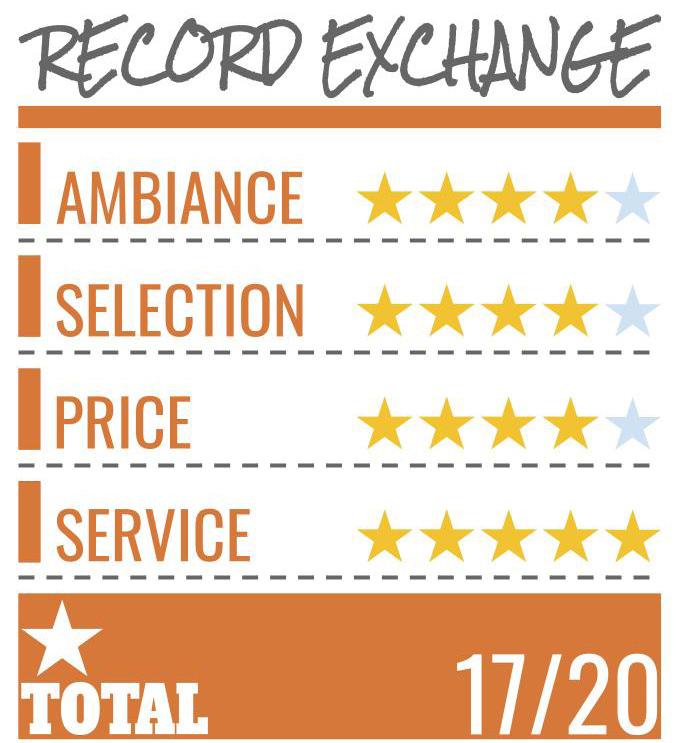


contact the editor: sports@alestlelive.com (618) 650-3528
BRANDI SPANN opinion editor
Baseball fans around the St. Louis area have formed teams that preserve the history of the game by wearing vintage uniforms, using traditional equipment and following rules from the 1800s.
“Vintage ‘base ball’ can refer to any base ball that’s played by the rules of an earlier era. There are hundreds of vintage teams across the United States,”
Chris “Bookworm” Duggan, co-captain of the Lafayette Square Cyclone Vintage Base Ball Club and president of the Greater Saint Louis Base Ball Historical Society, said. “We play a style of baseball that is particular to 1860.”
Each team has a home field. The Cyclones play at Lafayette Park.
“The Cyclone Base Ball Club was an actual ‘base ball’ team in South St. Louis back in the 1860s, and they played on the same field that we play on, which is neat,” Duggan said.
Duggan said he started playing vintage ‘base ball’ because of its unique pacing and tie to history.
“It looked like exactly the kind of speed that I was wanting. I thought it was really cool — the living history aspect of it. It looked like a fun way to play the game, to mix it up and play it by those arcane rules,” Duggan said.
Todd “Dutch” Eschman is the president of the Belleville Stags Vintage Base Ball Club, and he is the founder and captain of the team. They
play at the Moose Lodge 1221 in Swansea.
In 2014, Eschman’s business, Old Dutch Classic Bats, was the first winner of SIUE’s Small Business Development Center’s Small Business Challenge for his handmade ‘base ball’ bats.
Nineteenth century ‘base ball’ used wooden bats, and the handles were a little bit thicker than modern bats. They didn’t wear gloves, and vintage base balls don’t have a core like modern balls do.
“In 1860, there were only 36 rules in the book, and so a lot was left to interpretation,” Eschman said.
According to Eschman, the national vintage ‘base ball’ game was started in 1981 by the Ohio Village Muffins — a team that played at a historic site and began writing down their interpretation of the rules of ‘base ball’ from the 1860s.
As the game caught on and teams started to form around the country, historians discovered that there were variations to the rules.
“The St. Louis region adopted those Muffin rules,” Eschman said. “We, as the Belleville Stags, said.
‘We’re gonna go with the more historic interpretation that these researchers have come up with.’ We have some subtle differences between the rest of the circuit.
The teams know, when they come to our field, we play by these different sets of standards.”
Eschman said that there is artwork from the past that depicts first and second basemen playing on their respective bases.
This leaves a gap between first and second base. The Muffin rules set this as a standard, but John Thorn — Major League Baseball’s official historian — found anecdotal evidence that this isn’t really how they played, so the Stags let their second baseman play between first and second base.
Tony “Lightening” Wicker is the manager and owner of the Saint Louis Brown Stockings Vintage Base Ball Club.
“In 1858, the rule was free walkbacks on a fly ball. If a fielder catches the ball on the fly — meaning it doesn’t bounce — then the batter’s out and the runners on base can go back to the base. You can’t tag up, and they get a free walk back. If a ball goes foul, it’s the same thing,” Wicker said.
Duggan said that vintage rules require pitchers to throw underhand, and pitchers stand 45 feet from home plate, rather than the modern distance of 60 feet and six inches.
“The big thing people notice is that a ball that’s caught on one bounce is an out,” Duggan said. “A base runner doesn’t have to tag up to advance on a ball caught on the bounce, but you do just like the modern game on a ball caught on the fly.”
In 1869, the Cincinnati Red Stockings became the first professional ‘base ball’ team with salaried players. Eschman said that players had previously been wearing long pants to play base ball, which is what the Cyclones do, but the Red Stockings wore knickers that cut off at the knee to expose their socks, so the Stags do the same. They wear


knickers and socks, and they have shirts that lace-up to a red collar reminiscent of the uniforms from the 1870s.
“It’s kind of cool because then you can have conversations with fans and say, ‘Hey, look, this is how the uniform might have evolved,’” Eschman said.
“The Cyclones, for example … that’s what it would look like in 1860. We look like baseball in 1870. This team over here looks at baseball at the turn of the next century.”
Wicker said the Brown Stockings wear a wool hat with stripes, a white shirt, khaki pants and a brown belt reminiscent of the uniforms that the original St. Louis Brown Stockings team wore in 1875.
Duggan said the Cyclones wear short-billed caps, dockers and white jerseys with an insignia for Lafayette Park that buttons to the front.
St. Louis vintage base ball teams operate as independent teams, and they set up their own schedules with one another. Each team operates differently, but for the most part, players are required to buy their own uniform and then pay a small annual fee to cover operational expenses.
The St. Louis vintage base ball season begins St. Patrick’s Day weekend and runs
until shortly before Halloween. They open and close the season with a goodwill match — a chance for players from all of the local teams to get to know one another and warm up their skills before the season kicks off.
“We mix and match [players]. It’s just a way to get everybody outside and give everybody a chance to hit, throw and get the cobwebs off after the winter. Then we all hang out afterwards at the lodge,” Wicker said.
Teams play as often as possible and travel within a couple hours to play against other local teams. Vintage teams have players of all ages, and Eschman, Duggan and Wicker all said that they encourage people from the community to come get involved and watch them play.
“The future of preserving this kind of the game — this part of baseball history — lies with younger people taking it up,” Duggan said.
The Brown Stockings will host their annual St. Louis Cup on July 27, at Forest Park. They will be hosting 14 teams from five different states. All three teams are set to play at the Edwardsville Living History Days Festival on Oct. 5, at the Winston Brown Recreation Complex.

TORI WATERS copy editor
Before Caitlin Clark can strike gold, she needs to gain more experience and leave her unsportsmanlike attitude behind.
After being named Player of the Year by the University of Iowa and recently transitioning to the Women’s National Basketball Association’s Indiana Fever, it is obvious that Clark is a phenomenal athlete. Regardless of her unstoppable jump shots and impressive 40-foot shots, Clark should stick to the WNBA for the time being.
The 2024 USA Women’s National Team has 14 women who dominate the playing field. As a combined team, they hold 15 Olympic gold medals, 18 International Basketball Federation Women’s World Cup titles and 55 WNBA All-Star appearances. When adding Clark to this mix, she has not achieved any of these accomplishments. Clark has only started her first season in the WNBA, and she is predicted to be Rookie of the Year, but she has not won an official WNBA title.
Clark simply has not had the experience nor has worked as hard as the majority of the women on the USA Women’s National Team. Compare Clark to Olympian Brittney Griner — during her time playing for Baylor University, she won a national title and went 40-0 in the same year. These are achievements that Clark has not experienced during her time with the University of Iowa.
View
SIUE has demonstrated game; now it’s time to prove consistency
SAM MUREN managing editor
Throughout the year, SIUE saw several of their teams and individual athletes compete at the top level to achieve conference success demonstrating their ability to support the athletic program during notable achievements.
Men’s soccer, women’s tennis and men’s golf battled to top the Ohio Valley Conference this past year. Wrestling also sent senior wrestler Caleb Tyus to the National Collegiate Athletics Association Division I Championships.
SIUE showed they have teams that are capable of earning titles in their respective sports. The question remains though — are they capable of staying consistent?
Along with maintaining the success achieved this sea son, it is important to strive for growth as well.
make sure their voices still resonate with the players. Nowadays, in professional sports especially, coaches are often the first to get the boot due to teams falling into mediocrity.
The best way to address this and make sure the athletes feel the coaches are still worth listening to is by changing and improving the supporting staff. While it’s unfortunate, such changes are oftentimes necessary. By changing the support staff, athletes are more likely to feel like the team is searching for improvements without the need for a coaching change. This can be a difficult process, but one that is necessary in the sporting world.

It’s inevitable that each team will see changes during the off-season. Especially in college sports, athletes graduate, transfer or just change their focus. Unlike professional sports, you cannot sign athletes to long-term contracts to ensure your success.
It will be interesting to see how SIUE’s teams adapt to the losses they will face.
Graduated goalkeeper Sam Gomez was an essential piece of the men’s soccer team in their path to an NCAA tournament appearance. The losses of Shamar Wright and Lamar Wright as well as Damarco Minor will leave difficult roles to replace in the men’s basketball team.
Something else SIUE needs to focus on this off-season is the development of their key returning players. Each team saw an athlete that has the potential to be the face of their program, but it will be up to SIUE to make sure they each reach that potential.
Players like sophomore point guard Ava Stoller and junior tennis player Stefaniya Anikina could help determine the future of their teams. It will be important for SIUE to see these players succeed on the court, but also become the figurehead for their team in the community.
Both of these players are extremely talented at their sports, but their future success is important to their teams for different reasons.
el, when comparing Clark to long-time Olympian basketball players, she does not fit in.
Five-time Olympian Diana Taurasi has played more games than any other women’s player in USA Basketball Olympic history. Throwing Clark onto the court with these talented and experienced women would diminish her self-esteem. Taurasi expressed her feelings about Clark during “The Bird & Taurasi Show.”
“Not saying [Clark’s skills] are not gonna translate, because when you’re good at what you do, you’re just gonna get better,” Taurasi said. “But there is gonna be a transition period where you’re gonna have to give yourself some grace as a rookie.”
Stepping away from the obvious lack of familiarity with high-level intensity basketball play such as the Olympics, Clark’s attitude needs to be improved.

Clark is known for her disrespectful comments, giving referees dirty glares, shoulder checking and using her best acting skills to try to sell offensive fouls. While these certain tactics worked in college basketball and maybe a few times in the WNBA, it will not fly in the Olympics. When representing the United States, it is vital to play with the utmost respect and dignity. Having a bad attitude not only reflects negatively on Clark, but it would also look poorly on the Olympic team and Americans as a whole.
Those are just to name a few. Every team will likely see some changes before the start of the next year.

Focusing on scouting and signing athletes will determine the future of what SIUE’s potential success will be. Hope for a talented next crop of incoming freshmen will fall to luck, but attracting them will be up to SIUE’s recruitment strategies.
Part of that strategy should focus on the coaching staff, something I believe SIUE has shown tremendous success in doing. Men’s Soccer Head Coach Cale Wassermann, Men’s Basketball Head Coach Brian Barone and Tennis Head Coach Adam Albertsen have all proven to be stellar coaches.
Whether it is commitment to their program or their ability to draw the best from their athletes, each of them were key pieces to their team’s success.
Even teams that did not claim a title appear to have coaches that are committed to developing the program to get there one day. Women’s Basketball Head Coach Sam Smith and Baseball Head Coach Sean Lyons are two coaches that stand out to me.
Stoller is young blood for a rebuilding women’s basketball team. Her competitiveness and leadership will be looked upon while the team works to build their way up.
Anikina is in a different boat. Tennis showed they are a top team at the collegiate level, but her success will help determine if they continue to stay at the top.
Along with the necessity to develop the teams’ athletic abilities, the Athletics department will be responsible for continuing to grow the interest of these teams.
Collegiate sports is unfortunately a vicious cycle. If you want to see your teams improve, you have to show athletes that your programs are respectable and worth putting all your effort and heart into. However, if you want people to respect your teams enough to show up and support them, then you have to put forth a talented team that is capable of winning.
This is what SIUE needs to focus on this off-season to show they are more than just a one-year magic trick.
Each of their teams has pieces to the cycle that can lead them to success.
Shifting to a completely different lev-
Overall, Clark is underprepared for the Olympic experience. Luckily, she is truly just beginning her career, and there is a bright future ahead of her. However, before Clark can be considered an Olympic player, she needs to adjust to the WNBA and dispose of her negative attitude tendencies.
Despite their teams falling short of their desired outcomes, both coaches seem to have a vision for the future and are making efforts to help their players grow.
One thing to keep in mind for these programs and the coaches is to
Tennis and golf are both wildly successful teams, but lack the spirit of a fandom to hopefully continue to draw talent for the future. Teams like the basketball programs, soccer programs, baseball and softball all have the necessary tools and committed fans, but need to build their talent pools in order to keep them.
The off-season holds many questions on how committed SIUE is to consistency. They have laid solid groundwork during the season, but the key to continue their successes is to build on them in the coming months.


THE THRILL IS NOT GONE: BB King performs at the 1973 Mississippi River Festival. During the MRF revival, Tyler Bryant and The Shakedown, as well as Larkin Poe, acknowledged the history of music playing a large part in the Metro East, specifcally in the blues, jazz and rock ’n’ roll genres.
/ The Alestle archives
MOON LANDINGS AND THE MRF: The Mississippi River Festival began in 1969 and lasted until 1980. Above is the 1972 main tent surrounded by festival-goers. During the headline performances, the crowd usually grew to be in between 13,000 through 20,000 attendees. The orchestra performance would bring in about 8,000.
/ The Alestle archives
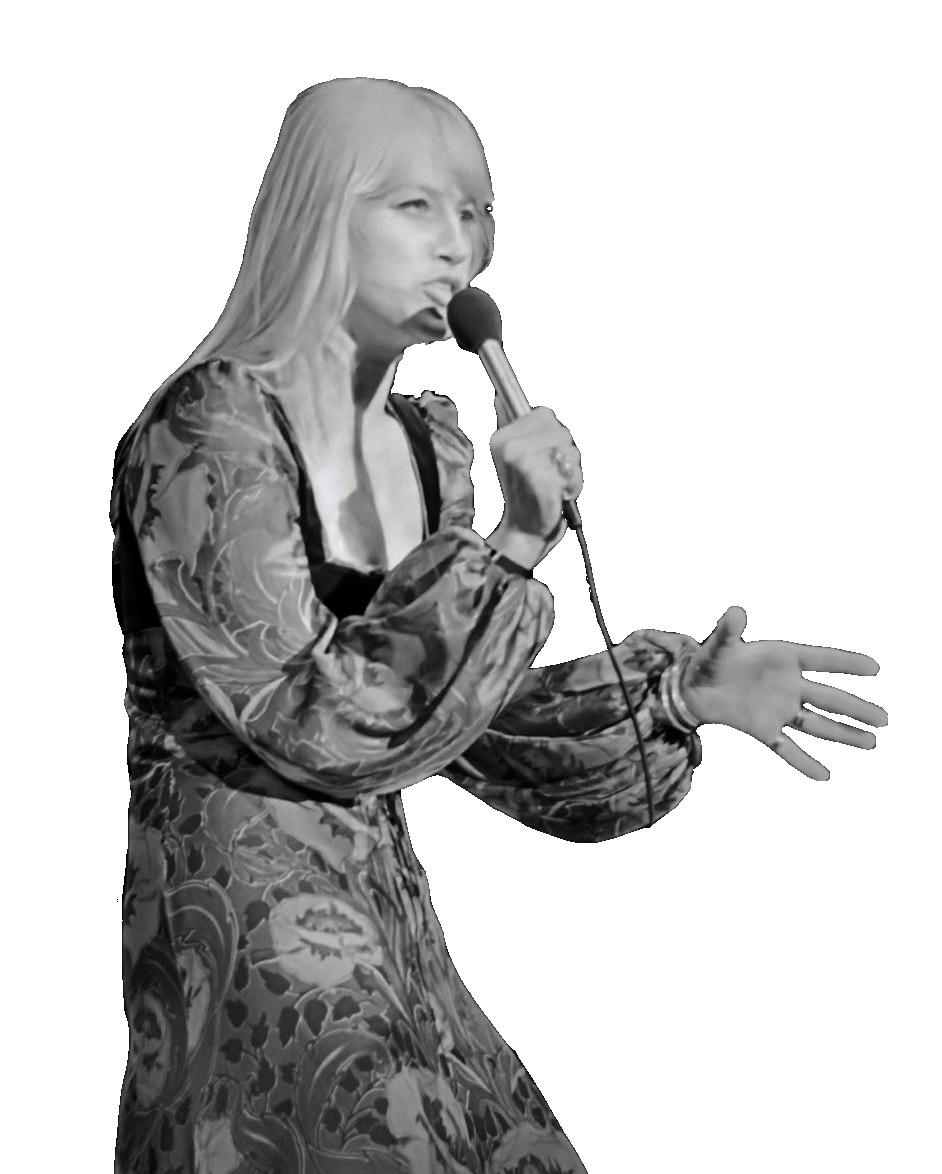
FOLLOW ME: Mary Travers was a folk singer popular in the 1960s. She performed at the MRF in 1973.
/ The Alestle archives


/ The Alestle archives
GOOD THERAPY: Scott Wilson Bill Robinson. In his hands, he holds a parking pass, his stage pass festival from when he was an assistant stage hand. Wilson said that working therapy as he had just been discharged the Vietnam War. He said that see the revival and hopes that it

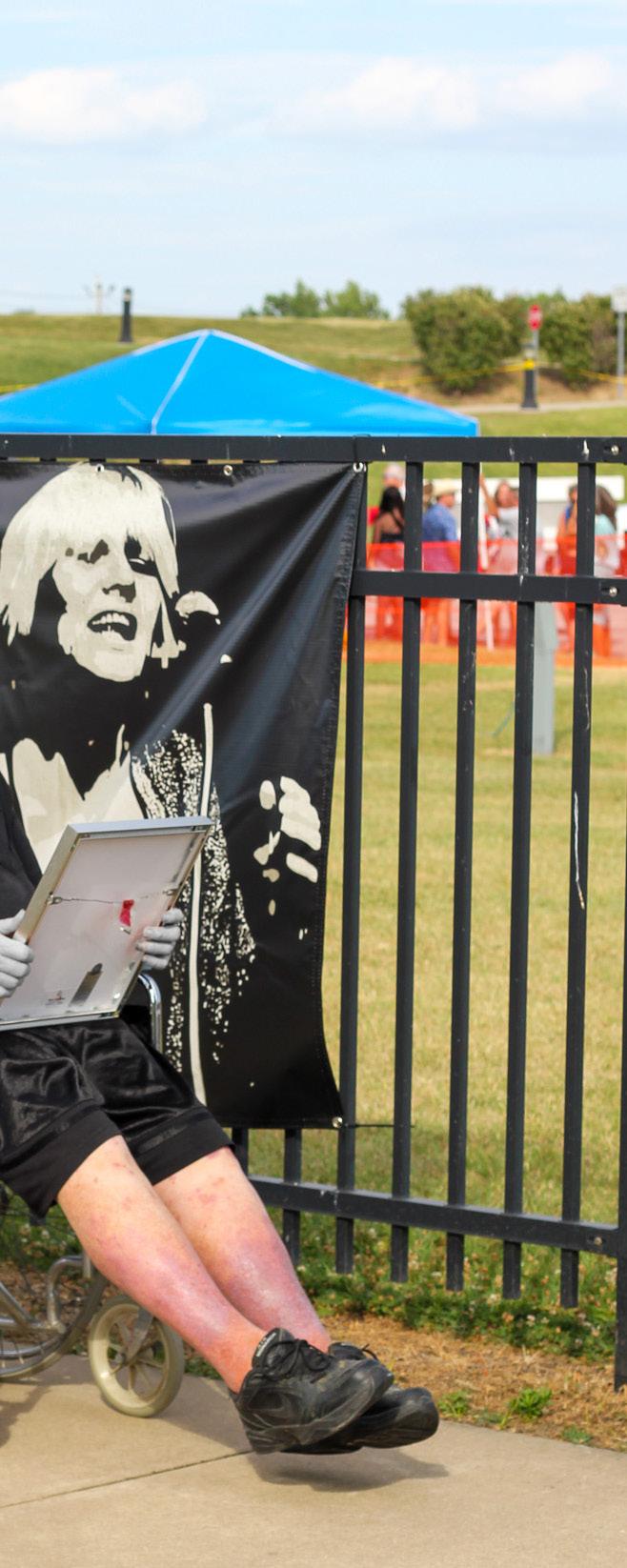
arrives at the MRF revival with holds a picture frame containing and MRF ID from the original assistant stage hand and then a working at the festival was good discharged from the army during he was excited to be alive to it continues.

0 2 4
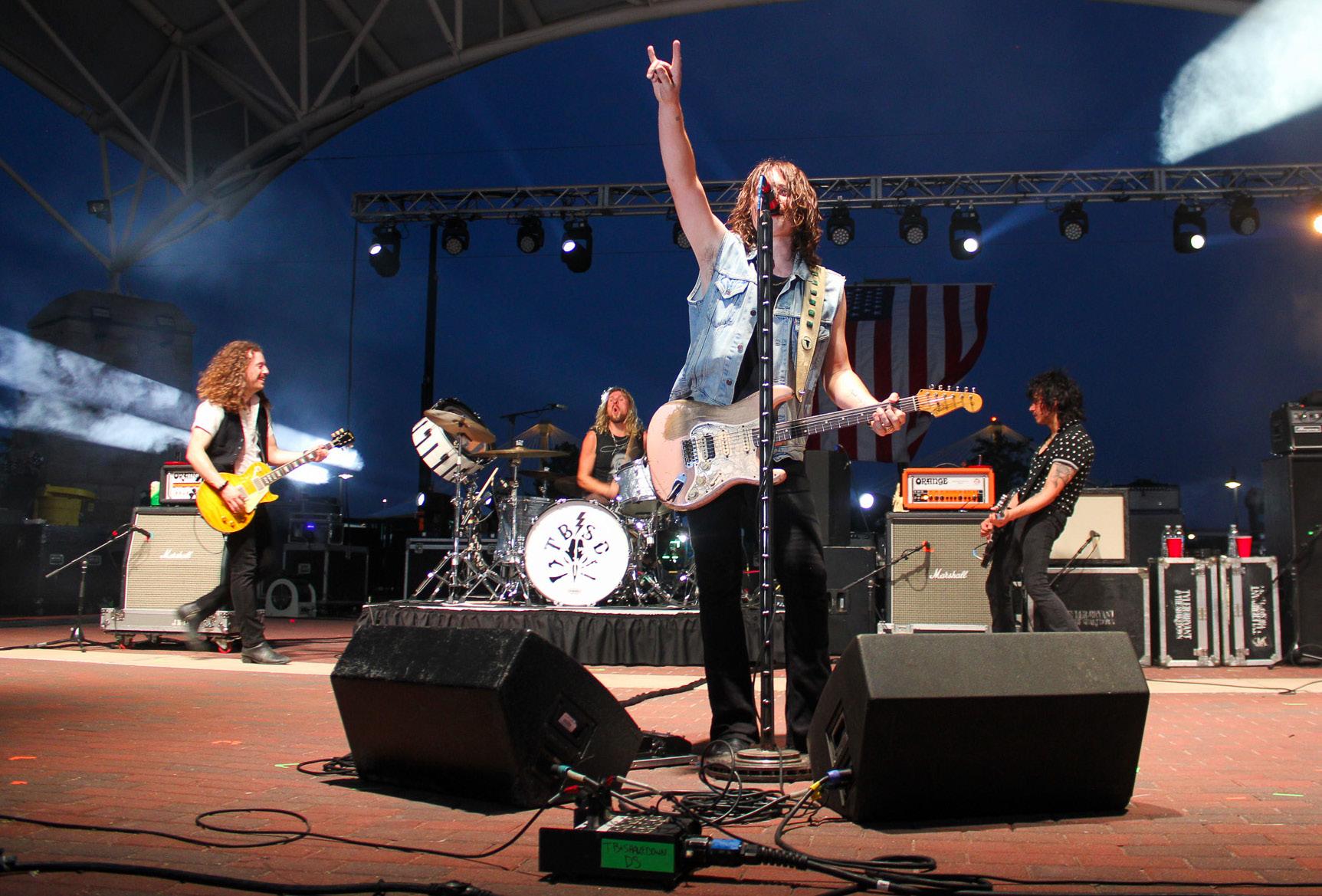
SHACKLES: Tyler Bryant, the lead singer of Tyler Bryant and The Shakedown, holds up the “rock on” sign during their set. The band interacted with fans at times, climbing the barricade to sing to the audience and hand out guitar picks and drumsticks. In the crowd was Jessica Isom, who runs their fan page. Isom said that the MRF was the 45th time she had seen the band.
SELF-MADE MEN: Rebecca Lovell danced around the stage playing her guitar during Larkin Poe’s set. The band is led by two sisters, Megan and Rebecca Lovell, who play the slide guitar and guitar, respectively. During the concert, they honored the history of blues by playing “Preachin’ the Blues” by Son House.
FESTIVAL | PAGE 3
This year’s festival director, Nick Bifano, brought the original festival director, Lyle Ward, onto the stage before the performances began.
“We hope that this goes many years into the future to preserve the legacy of what [Lyle] started,” Bifano said.
Ward addressed the audience and expressed his hopes for the future of the festival.
“I hope that you will support this organization and make it grow and be an asset to the community,” Ward said. “I think it will.”
to the community, even if the circumstances of the original festival were unique to the time.
“It’s wonderful to see those river towns that are so precious to me … thrive in any way [they] can,” Weil said. “There’s a lot to be said for honoring the tradition that was there, even if it can’t be duplicated.”

Ward has set up an exhibit honoring MRF at the Madison County Historical Museum and Archival Library. The exhibit will be on display until the end of July. Ward is present at the exhibit every Sunday. He also contributed to the two movies about the festival that are available through Lovejoy Library’s archives.
“My goal was to keep MRF in memory,” Ward said. “I’m a great supporter of what they’re doing … They never intend to try to replace the old MRF. It’s not possible.”
1981-1982 Alestle Editor-in-Chief Nancy Weil attended the original festival before and during her time at SIUE. She went for the first time when she was 13, when tickets cost around $2.
“Performers loved playing there. I know folks who were musicians at that time. That was one of the places they loved to play,” Weil said. “It just had an electric environment to it, because it was big and open and loud.”
Weil said that the location of the natural amphitheater on the SIUE campus was central to the spirit of the festival, and she is excited that the Liberty Bank Alton Amphitheater is trying to bring that back


“There’s a long history that folks love to fill you in on and memories that people have of what it was like to go to shows there. It’ll forever be one of my favorite places to see a show. I miss it. I’ll always miss it. Anybody who went to shows there speaks of it wistfully,” Weil said.
Mitzi Jacobsen has been a traveling fan of Tyler Bryant & the Shakedown for about five years. Her first concert as a kid was Mac Davis and Captain & Tennille at the Mississippi River Festival when it was at SIUE.
“Everybody had fond memories of [MRF], whether you were a kid or an adult. It was gone for so many years — I think everybody is thrilled that it’s back. I’ve seen so many people with old ticket stubs and T-shirts,” Jacobsen said. “It was before all the big amphitheaters, so it was kind of the first of its kind. To see it come full circle is really neat.”
Goins said that this year’s festival was a trial run on a smaller scale to gauge how the city would proceed if they decided to host it annually.
Pierce said the organizers have started thinking about what this could become, and they’ve started talking about reaching out to potential acts for next year.
John S. Rendleman, SIUE’s 19801981 student president and son of former SIUE President John Rendleman, fondly
remembers the original festival and its impact on the university and community.
“We got some acts which were obscure to the St. Louis audience but who really had a big presence nationally and internationally. About the time [MRF] began, there was a St. Louis radio station [KSHE] that switched over from whatever it was playing and started playing rock and roll and not pop … which introduced a lot of bands to kids my age and others and helped advertise the Mississippi River Festival,” Rendleman said.
Rendleman said that he started going to the festival around the age of nine or 10 alongside his father.

“Since I was a little kid running around, they let me take concessions back to the green room. I remember serving Bob Dylan some Coca-Colas,” Rendleman said.
Rendleman said that, during his years at SIUE, he lived in an apartment that abutted a field of soybeans. Across the
field was a place called the “farmhouse,” and that was the place where he met the Grateful Dead.
“After the Mississippi River Festival concert of the Grateful Dead, me and my buddy went home and heard that there was a party across the field. We went there, and the members of the Grateful Dead were sitting on old, beat-up couches, and they were hanging out and partying. I sat on the back porch with Jerry Garcia three feet from me just strumming his guitar,” Rendleman said.
“I hope the venue in Alton experiences the same thing that we did, because most of the kids I grew up with — and we’re still friends we remember the Mississippi River Festival as the good old days,” Rendleman said.
Kerber has worked at Lovejoy Library since 1995. He said that people would often call the library asking questions about the festival, and he attributes this to nostalgia.
“They have wonderful, pleasant memories of MRF,” Kerber said.
“They were growing up and blossoming as individuals, and this was the music of their youth.”
Even though the original festival can never be replicated, Kerber said that the relationship between the performers and the audience will be special forever.
“Everybody will have a great time, and there will be some really good music. It will be something different, and hopefully, this will find a life and a future of its own,” Kerber said.

